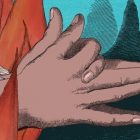The Horror of Circumstance in Bora Chung’s Cursed Bunny
 Partway through reading “The Head,” the first story in Cursed Bunny, a collection of ten stories written by Bora Chung and translated from Korean by Anton Hur, I began to wonder why the story’s main character, a young woman, was being haunted by a bodiless head that would pop out of the toilet bowl to call her “Mother.” The head itself—not quite a head, really, but rather something that “resembled a lump of carelessly slapped-together yellow and grey clay, with a few scattered clumps of wet hair”—offers an explanation: “My body was created with the things you dumped down the toilet, like your fallen-out hair and feces and toilet paper you used to wipe your behind.” But why is this particular woman being haunted in this particular way?
Partway through reading “The Head,” the first story in Cursed Bunny, a collection of ten stories written by Bora Chung and translated from Korean by Anton Hur, I began to wonder why the story’s main character, a young woman, was being haunted by a bodiless head that would pop out of the toilet bowl to call her “Mother.” The head itself—not quite a head, really, but rather something that “resembled a lump of carelessly slapped-together yellow and grey clay, with a few scattered clumps of wet hair”—offers an explanation: “My body was created with the things you dumped down the toilet, like your fallen-out hair and feces and toilet paper you used to wipe your behind.” But why is this particular woman being haunted in this particular way?
These questions aren’t the right sort to ask about this story or many of the others in this collection, which Chung has characterized “like fairy tale[s], but with a little bit of a modern Korean twist.” As in fairy tales, settings are generic, characters are unnamed, plots unfold according to dream logic, and the situation is a given, the way that the accident of one’s birth to a particular set of parents in a particular time and place is a given. What matters is not so much the unknown specifics of the character’s background or life, but rather what the character does in the strange situation they find themselves in.
In the case of the haunted woman, she rejects the head. “This is my toilet,” she says, “so of course I’m going to use it like I always have. But I can’t bear to think of a creature like you living in it. Finishing your body is none of my concern. I don’t care what you do, and I’d appreciate it if you stopped appearing.” For a time, she is so concerned about the possible appearance of the head in the toilet that she becomes constipated and develops an inflamed bladder. Later, she tries unsuccessfully to destroy the head. Her family and husband tell her not to worry about the head—at least it’s not laying eggs, they say. In the end, though, when the woman has grown old and the head has completely made itself into a replica of her younger self, it seems that perhaps she was right to worry. Each resents the other equally, but one is stronger than the other.
Despite its evident power to form itself from feces and trash, the head expresses an existential helplessness, complaining, “Did I ask you to give birth to me?” The woman is similarly helpless in avoiding or stopping the head—though I do wonder if ironically it is her rejection of the head and what it represents that led to its creation and power. Helplessness or bewilderment is common to many of the characters in Chung’s stories; they are like characters caught in a bad dream from which there is no waking, and in which the interdependence of living things is experienced as horror. Bodies are made from other bodies, as in “The Head” and “The Embodiment,” two stories about aberrant births. Even more horrifying, bodies feed on other bodies, as in “Snare” and “Scars,” the two most disturbing stories in the collection.
“Snare” begins with a man’s discovery of a fox caught in a snare and bleeding gold. He keeps the fox in the snare, hiding her in his shed and regularly wounding her again so that he can harvest her blood, which he sells bit by bit in different places in order to create the illusion that he is nothing more than an especially prosperous peasant rather than a man who cultivated a secret source of gold. His depravity becomes even more horrifying after the fox dies and his twin children—a boy and a girl—are born, and a gruesome recapitulation of his relationship with the fox begins. This time, the man discovers that after the boy feeds vampire-like on his sister, he bleeds gold. The man comes to rely on his children as he once did the fox, imprisoning them and thinking of his daughter “as no more than food for his son, who in turn was just gold for his purse.” His insatiable, parasitic appetite for gold ensnares his family, which over time consumes itself.
In “Snare,” the narrator begins, “This is a story I once read long ago,” and continues with the conventional opening, “Once upon a time…” As in a conventional fairy tale, the narrator remains distant from the interior lives of its wretched characters. In “Scars,” on the other hand, the third-person narrator tells the story from the point of view of a youth who, like the twins in “Snare,” is imprisoned and exploited. He is first given as an offering to a monstrous bird called It that periodically feeds on his marrow, and later, after he escapes, is taken in as a fighter and deployed against dogs, wolves, boars, a bear, and, eventually, other men. Though the youth is wily when he puts his mind to escaping or combating It, he is not in control of himself when he fights, blacking out as he wreaks terrible violence: “Whatever his opponent, the only things he could remember of the fights themselves were the fear and tension, the pain of his body shattering into pieces, and a piercing sound of breakage. Then, strangely enough, he would come to and the beast would be lying with its neck broken or stomach ripped open, its guts spilled all over the ground.” He is so helpless in the face of his own violence that when he is set to fight men, he is given a concoction that weakens him, because otherwise he would not be able to stop himself from killing his opponent.
After he is cast away by the man who made him fight, the youth asks the question that the woman in “The Head” never asks: Why me? He wonders: “What was this monster? And why did it need sacrifices? And why had he been selected for that sacrifice?” The answer, in part, has to do with an accident of birth: he was orphaned. He comes to see clearly what this vulnerability led to for him: “Every person has only one childhood, and instead of being full of hopes or dreams, his had been crushed by the fight for survival. He never once imagined in all his years spent in the cave that a different childhood from the one that had been accorded to him might have been possible.”
Of course, as the twins in “Snare” know, being born into a family with two living parents is no guarantee of a better childhood. Their father’s greed curses and destroys the entire family. Money troubles, greed, and the desire for revenge lead to uncontainable destruction in several of the stories in Cursed Bunny, such as in the title story, in which a cursed fetish object—a lamp in the shape of a bunny—leads to the ruin not just of the intended target, the man who cursed him, but also to his family. Or in “Ruler of Sands and Winds,” the lifting of a curse reveals the rapacious greed of those who had been cursed. What is most disturbing in “Scars” is that something more fundamental than greed was the original cause of the youth’s suffering: the desire simply to survive. As he ultimately discovers, the relationship between It and the village that once gave the youth as an offering was more symbiotic than parasitic.
Does survival truly require the sacrifice of others? The youth in “Scars,” at least, who has been a victim of both, perceives a distinction between humans, who at times “derive satisfaction from scaring or torturing others,” and beasts: “As long as they can prevent themselves from being killed while having prey in their grasp, animals don’t need to concern themselves with the feelings of their prey; simply the fact of having prey in their grasp is enough satisfaction.” In this distinction, however, little comfort is to be found.



